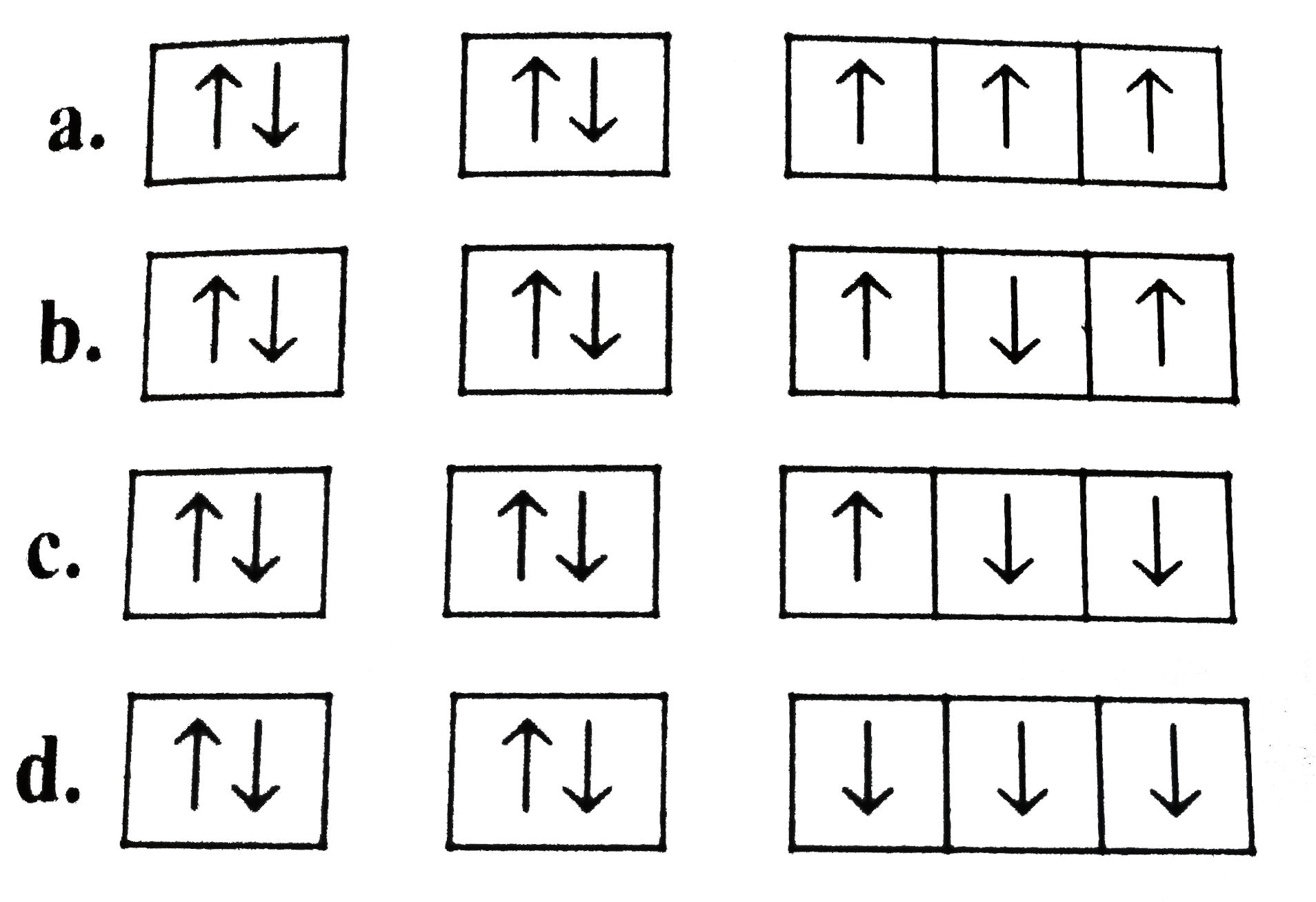State Hund's rule of maxium multiplicity. How is it used in electronic distribution in nitrogen atom ?
The correct Answer is:Hund's rule: No electron pairing takes place in the orbitals in a sub-shell untill each orbital is occupied by one electron with parallel spin. Exactly half filled and fully filled orbitals make the atoms more stable, i.e., and configuration are most stable.
Step-by-Step Solution
Step 1: State Hund's Rule of Maximum Multiplicity
Hund's rule of maximum multiplicity states that in a given subshell, electrons will occupy degenerate orbitals (orbitals of the same energy) singly first, before any pairing occurs. Furthermore, all singly occupied orbitals will have electrons with the same spin (parallel spins). This arrangement minimizes electron-electron repulsion and leads to greater stability.
Step 2: Apply Hund's Rule to the Nitrogen Atom
The atomic number of nitrogen (N) is 7, which means it has 7 electrons. The electronic configuration of nitrogen can be written as follows:
- The first two electrons fill the 1s orbital: 1s²
- The next two electrons fill the 2s orbital: 2s²
- The remaining three electrons will occupy the 2p orbitals.
Step 3: Distribute Electrons in the 2p Orbitals
The 2p subshell consists of three degenerate orbitals (2p_x, 2p_y, and 2p_z). According to Hund's rule:
- The first electron goes into the 2p_x orbital.
- The second electron goes into the 2p_y orbital.
- The third electron goes into the 2p_z orbital.
All three electrons in the 2p orbitals will have parallel spins, resulting in the configuration: 2p³.
Step 4: Summarize the Electronic Configuration
The complete electronic configuration of nitrogen is:
- 1s² 2s² 2p³
This configuration is stable due to the half-filled 2p subshell, which is in accordance with Hund's rule.
Hund's rule of maximum multiplicity states that in a given subshell, electrons will occupy degenerate orbitals (orbitals of the same energy) singly first, before any pairing occurs. Furthermore, all singly occupied orbitals will have electrons with the same spin (parallel spins). This arrangement minimizes electron-electron repulsion and leads to greater stability.
The atomic number of nitrogen (N) is 7, which means it has 7 electrons. The electronic configuration of nitrogen can be written as follows:
- The first two electrons fill the 1s orbital: 1s²
- The next two electrons fill the 2s orbital: 2s²
- The remaining three electrons will occupy the 2p orbitals.
The 2p subshell consists of three degenerate orbitals (2p_x, 2p_y, and 2p_z). According to Hund's rule:
- The first electron goes into the 2p_x orbital.
- The second electron goes into the 2p_y orbital.
- The third electron goes into the 2p_z orbital.
The complete electronic configuration of nitrogen is:
- 1s² 2s² 2p³
Topper's Solved these Questions
- NUCLEAR CHEMISTRYBOOK - RESONANCE ENGLISHCHAPTER - NUCLEAR CHEMISTRYEXERCISE - Exercise-1
45 Videos
- NUCLEAR CHEMISTRYBOOK - RESONANCE ENGLISHCHAPTER - NUCLEAR CHEMISTRYEXERCISE - PART -II
32 Videos
- NUCLEAR CHEMISTRYBOOK - RESONANCE ENGLISHCHAPTER - NUCLEAR CHEMISTRYEXERCISE - MISCELLANEOUS SOLVED PROBLEMS (MSPs)
9 Videos
- NITROGEN CONTAINING COMPOUNDSBOOK - RESONANCE ENGLISHCHAPTER - NITROGEN CONTAINING COMPOUNDSEXERCISE - ORGANIC CHEMISTRY(Nitrogen containing Compounds)
30 Videos
- P BLOCK ELEMENTSBOOK - RESONANCE ENGLISHCHAPTER - P BLOCK ELEMENTSEXERCISE - PART -II
23 Videos
Similar Questions
Knowledge Check
Which of the following is not correct for electronic distribution in the ground state?
A B
B C
C D
D
Quantum number area assigned to get complete information of electrons regarding their energy angular momentum ,spectral lines etc. Four quantum number are known i.e principal quantum numbers which tell the distinct shell and its angular momentum .Azimuthal tell about subshell and Magnetic quantum number deals with different orbitals in subshell. spin quantum number defines the spin of electrons designated as +12or−12
Electrons are filled in orbitals according to Hund's rule of maximum multiplicity .
Two unpaired electrons present in carbon atom are different with respect to their :
View SolutionAnswer the following questions:
(i) (1) State Hund.s rule of maximum multiplicity.
(2) Name the principle by which Electrons are filled in various orbitals in the increasing order of energies and fill up the orbitals of lower energy first.
View SolutionWhich of the following correctly represent the electronic distribution in the Mg atom?
View SolutionState True or False:
Multiplication is distributed over addition.
View SolutionThe correct state electronic configuration of chromium atom is
View SolutionThe ground state electronic configuration of nitrogen atom can be represented as:
View SolutionThe ground state electronic configeration of nitrogen atom can be represented by

View Solution
